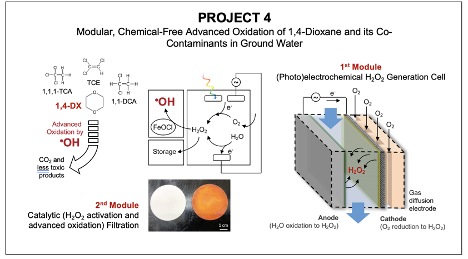Biomedical Research Project 4
Modular, Chemical-Free Advanced Oxidation of 1,4-Dioxane and its Co-Contaminants in Groundwater
Goal
Research Project 4 team's goal is to design, fabricate, test, and implement point-of-use small-scale water treatment units that contain reactors that destroy 1,4-DX and its co-occurring contaminants from contaminated groundwater through advanced oxidation processes (AOPs). The prototype reactors will be tested in the lab and in the field in collaboration with other project teams to verify the feasibility of real world use, confirm the elimination of human toxicity, and establish faster technology transfer.
Description
A prototype AOP reactor will be developed that employs a new catalyst that can selectively produce high concentrations of H2O2 using only water and oxygen as a source. Another newly-developed catalyst will activate the H2O2 to produce •OH without any external energy/chemical supplies and without producing undesirable byproducts (which would otherwise require additional treatment).
When coupled, these systems will enable, for the first time AOP of groundwater in a small, compact, distributed water treatment system. The performance of prototype reactors will be tested and compared with a benchmark UV/H2O2 process (i.e., adding H2O2 and irradiating UV light). This will involve a comprehensive analysis of the efficiency of 1,4-DX destruction, as well as the evolution of reaction byproducts.
Reduction of the deleterious effects of consuming 1,4-DX-containing water will be investigated in collaboration with the Research Project 1 team. The prototype reactors will undergo testing in select field sites (identified as being contaminated by Research Project 2) to determine their efficiency under real world situations and their activity under long term conditions (employing sensors developed by Research Project 3).

Relevance
An AOP that employs highly reactive •OH as main oxidant is considered to be the most effective among established water treatment methods for the destruction of pollutants, such as 1,4-DX and its co-occurring contaminants from contaminated groundwater. However, enabling AOP in a small-scale, distributed system (i.e., in contrast to centralized large-scale treatment and water delivery through a network of pipes) is technically challenging due to the requirement for a precursor chemical (H2O2) that needs to be activated on site to produce •OH and the high energy demand.
The research will, for the first time, enable off-grid, decentralized advanced oxidation treatment of ground water in households that achieves destruction—not physical removal—of 1,4-DX (and its co-occurring contaminants) to benign end-products. Modular reactors developed in our research will not require a continuous chemical supply (unlike any existing oxidation process).
In addition, they will either be solar powered (complete off-grid) or use a much smaller amount of electricity (e.g., using solar photovoltaics or existing electricity grid) than conventional AOPs that employ more energy-consuming UV irradiation.
Members
Project Leaders: